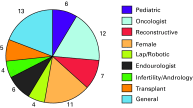Human resource assessment of academic urology across Canada: What are the future job prospects?
- PMID: 23826042
- PMCID: PMC3699074
- DOI: 10.5489/cuaj.198
Human resource assessment of academic urology across Canada: What are the future job prospects?
Abstract
Introduction: Our objective was to capture an overview of anticipated staffing needs at Canadian urology academic centres over the next 5 years to help guide and counsel urology residents in their respective programs.
Methods: A 30-question survey was sent by email to all chairmen of academic urology divisions/departments during fall 2012. The first part of the survey solicited basic demographic information regarding number of residents, number of fellows and fellowships, and number of attending staff and affiliated hospitals. The second part of the survey included detailed questions on the number and sub-specialty of urologists needed at each respective institution, as well as the appropriate year of recruitment.
Results: The response rate was 100%. There are 13 urology training programs across Canada located in 6 out of the 10 provinces. Robotic surgery is available at 9 out of the 13 centres. A total of 68 urologists need to be recruited by academic institutions throughout Canada within the next 5 years. The greatest need is for general urologists, with a total of 13 required. This is followed by 12 urologic oncologists needed, 11 female urology, 7 reconstructive urologists, 6 pediatric urologists, 6 endourologists, 5 transplant surgeons, 4 infertility/andrology, and 4 experts in advanced laparoscopy/robotics. There was no need for any urologic trauma surgeons in any academic institution surveyed.
Conclusions: A total of 68 urologists need to be recruited into academic urology across Canada within the next 5 years. This crucial information can be used to help guide urology residents in choosing the most appropriate fellowship, in addition to providing them with an overview of future job prospects at academic institutions throughout the country.
Figures





References
-
- The Canadian Post M.D. Education Registry (CAPER). www.caper.ca. Accessed May 14, 2013.
LinkOut - more resources
Full Text Sources
Other Literature Sources
